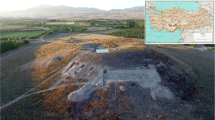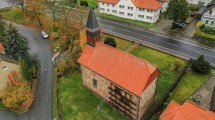Abstract
The eighth century BCE city at Tel ‘Eton (Israel) was destroyed by the Assyrian army, probably during Sennacherib’s campaign of 701. Building 101, sealed within the heavy conflagration caused by this destruction, was uncovered almost in its entirety on the top of the mound. From the beginning, it was apparent that the structure had two major building phases, and while its initial construction was of high quality, later additions were much inferior. Analyses of mud-brick walls for firing temperatures, texture, carbonate content, color, and dimensions approved the observation regarding the differences between the two phases, but consistently pointed out that one wall, initially attributed to the first phase, was analytically different, comprising an intermediate phase. This conclusion not only altered our understanding of the building construction, adding heretofore unknown building phase, but also gave us insights into the pre-planning of Building 101, indicating that some rooms had originally two doorways. Such a configuration allowed easy subdivision of spaces according to needs, without harming the overall structural stability. Differences in inner division of similar Iron Age houses were identified in the past and were attributed to differences in the life cycles of families. The evidence from Tel ‘Eton suggests that such future changes were taken into considerations when the structures were built.







Similar content being viewed by others
Notes
While other methods are commonly used (pipette method or hydrometer method), the advantage of the method used here is its accuracy. Its main shortcoming is that it is time-consuming due to the sedimentation time and the number of decantation cycles (it took us 3–4 weeks for sets of 20 samples).
We should note that in all the material that was sifted out from the samples, we did not find pottery sherds or other artifacts, and only a few small stones were identified.
For details on the provenance of the environmental samples see Forthcoming, Sapir Y, Sarah P, Sapir Y, Katz H, and Faust A. How are Tells Formed? On the Formation of Mound Topsoil at Tel ‘Eton.
References
Adam JP (2005) Roman building: materials and techniques (translated by Matthews A). Routledge, London
Albright WF (1941-1943) The excavation of Tell Beit Mirsim, III: the Iron Age (AASOR, 21–22). ASOR, New Haven.
Ayalon E (1985) Trial excavation of two Iron Age strata at Tel ‘Eton. Tel Aviv 12:54–62. doi:10.1179/tav.1985.1985.1.54
Baver LD (1956) Soil physics, 3rd edn. Wiley, New York
Berna F, Behar A, Shahack-Gross R, Berg J, Boaretto E, Gilboa A, Sharon I, Shalev S, Shilstein S, Yahalom-Mack N, Zorn JR, Weiner S (2007) Sediments exposed to high temperatures: reconstructing pyrotechnological processes in Late Bronze and Iron Age strata at Tel Dor (Israel). J Archaeol Sci 34:358–373. doi:10.1016/j.jas.2006.05.011
Brown PW, Clifton JR (1978) Adobe. I: the properties of adobe. Stud Conserv 23:139–146. doi:10.2307/1505842
Bunimovitz S, Faust A (2002) Ideology in stone, understanding the four room house. BAR 28:32–41 59-60. ISSN: 00989444
Certini G (2005) Effects of fire on properties of Forest soils: a review. Oecologia 143:1–10. doi:10.1007/s00442-004-1788-8
Chambon A (1984) Tell El-Far’ah, I. Éditions Recherche sur les Civilizations, Paris
Dar S (1986) Hirbet Jemein - a first temple village in western Samaria. In: Dar S, Safrai Z (eds) Shomron studies. Hakibutz Hameuchad, Tel Aviv, pp. 13–73
Emery VL (2011) Mud-brick. In: Wendrich W (ed) UCLA encyclopedia of Egyptology. Los Angeles
Fathy H (1973) Architecture for the poor. University of Chicago Press, Chicago and London
Faust A (1999) Differences in family structure between cities and villages in Iron Age II. Tel Aviv 26:233–252. doi:10.1179/tav.1999.1999.2.233
Faust A (2000) The rural community in ancient Israel during the Iron Age II. BASOR 317:17–39. doi:10.2307/1357482
Faust A (2008) Settlement and demography in seventh century Judah and the extent and intensity of Sennacherib’s campaign. Palest Explor Q 140:168–194. doi:10.1179/174313008X341528
Faust A (2011) The excavations at Tel ‘Eton (2006–2009): a preliminary report. Palest Explor Q 143:198–224. doi:10.1179/003103211X13092562976171
Faust A (2012) The archaeology of Israelite society in Iron Age II. Eisenbrauns, Winona Lake
Faust A. (2014) The history of Tel ‘Eton following the results of the first seven seasons of excavations (2006–2012). In: Bieliński P, Gawlikowski M, Koliński R, Ławecka D, Sołtysiakand A, Wygnańska Z (Eds), Proceedings of the 8th international congress on the archaeology of the ancient Near East (ICAANE): 30 April – 4 May 2012, University of Warsaw (Volume 2, Excavations and progress reports). Harrassowitz, Wiesbaden, pp 585–604
Faust A, Bunimovitz S (2003) The four room house: embodying Iron Age Israelite society. Near East Archaeol 66:22–31 ISSN: 1094-2076.
Faust A, Bunimovitz S (2014) The house and the world: the Israelite house as a microcosm. In: Albertz R, Alpert Nakhai B, Olyan SM, Schmitt R (eds) Family and household religion: toward a synthesis of Old Testament studies, archaeology, epigraphy, and cultural studies. Eisenbrauns, Winona Lake, pp. 143–164
Faust A, Eshel E (2012) An inscribed bulla with grazing doe from Tel ‘Eton. In: Lundberg MJ, Fine S, Pitard WT (eds) Puzzling out the past. Leiden, Boston, pp. 63–70
Faust A, Katz H (2015) A Canaanite town, a Judahite center, and a Persian Period fort: excavating over two thousand years of history at Tel ‘Eton. Near East Archaeol 78:88–102 . doi:10.5615/neareastarch.78.2.0088 with contribution by Farber Z, Sapir Y, Avraham A, Libi S
Forget MCL, Regev L, Friesem DE, Shahack-Gross R (2015) Physical and mineralogical properties of experimentally heated chaff-tempered mud bricks: implications for reconstruction of environmental factors influencing the appearance of mud bricks in archaeological conflagration events. J Archaeol Sci: Reports 2:80–93. doi:10.1016/j.jasrep.2015.01.008
Friesem DE, Tsartsidou G, Karkanas P, Shahack-Gross R (2014) Where are the roofs? A geo-ethnoarchaeological study of mud brick structures and their collapse processes, focusing on the identification of roofs. Archaeol Anthropol Sci 6:73–92. doi:10.1007/s12520-013-0146-3
Geva S (1989) Hazor, Israel: an urban community of the 8th century BCE (BAR International Series, 543). BAR, Oxford
Goldberg P (1979) Geology of Late Bronze Age mudbrick from Tel Lachish. Tel Aviv 6:60–67. doi:10.1179/033443579788497478
Goodman-Elgar MA, Bettencourt NS, Conrey R (2015) Geochemical characterization of Bolivian Formative earthen architecture by wavelength-dispersive x-ray fluorescence. Geoarchaeology 30:32–58. doi:10.1002/gea.21500
Graham DJ, Midgley NG (2000) Graphical representation of particle shape using triangular diagrams: an Excel spreadsheet method. Earth Surf Process Landf 25:1473–1477. doi:10.1002/1096-9837(200012)25:13<1473::AID-ESP158>3.0.CO;2-C
Holladay JS (1997) Four room house. In: Oxford encyclopedia of archaeology in the Near East. Oxford University, New York
Homsher RS (2012) Mud bricks and the process of construction in the Middle Bronze Age southern Levant. BASOR 368:1–27. doi:10.5615/bullamerschoorie.368.0001
Katz H, Faust A (2012) The Assyrian destruction layer at Tel ‘Eton. Israel Explor J 62:22–53 ISSN: 0021-2059
Kemp B (2000) Soil (including mud-brick architecture). In: Nicholson PT, Shaw I (eds) Ancient Egyptian materials and technology. Cambridge University Press, Cambridge, pp. 78–103
Kempinski A, Reich R (eds) (1992) Architecture of ancient Israel from the prehistoric to the Persian period. Israel Exploration Society, Jerusalem
Ketterings QM, Bigham JM (2000) Soil color as an indicator of slash-and-burn fire severity and soil fertility in Sumatra, Indonesia. Soil Sci Soc Am J 64:1826–1833. doi:10.2136/sssaj2000.6451826x
Lawrence DL, Low SM (1990) The built environment and spatial form. Annu Rev Anthropol 19:453–505. doi:10.1146/annurev.an.19.100190.002321
Loeppert RH, Suarez DL (1996) Carbonate and gypsum. In: Sparks DL, Page AL, Helmke PA, Loeppert RH, Soltanpour PN, Tabatabai MA, Johnson CT, Sumner ME (eds) Methods of soil analysis: part 3 chemical methods. SSSA, Madison Wisconsin, pp. 437–474
Love S (2012) The geoarchaeology of mudbricks in architecture: a methodological study from Çatalhöyük, Turkey. Geoarchaeology 27:140–156. doi:10.1002/gea.21401
Moore H (1986) Space, text and gender: an anthropological study of the Marakwet of Kenya. Cambridge University Press, Cambridge
Nafsika E, Athanassios B, Fani V (2014) Mud brick architecture and the case of Korestia villages in Greece. Sustain Mediterr Constr 1:18–22
Netzer E (1992) Domestic architecture in the Iron Age. In: Kempinski A, Reich R (eds) Architecture of ancient Israel from the prehistoric to the Persian period. Israel Exploration Society, Jerusalem, pp. 193–201
Nicholson PT, Shaw I (eds) (2000) Ancient Egyptian materials and technology. Cambridge University Press, Cambridge
Nodarou E, Frederick C, Hein A (2008) Another (mud)brick in the wall: scientific analysis of bronze age earthen construction materials from East Crete. J Archaeol Sci 35:2997–3015. doi:10.1016/j.jas.2008.06.014
Parker Pearson M, Richards C (1994) Architecture and order: approaches to social space. Routledge, London and New York
Pomies M, Morin G, Vignaud C (1998) XRD study of the goethite-hematite transformation: application to the identification of heated prehistoric pigments. Eur J Solid State Inorg 35:9–25. doi:10.1016/S0992-4361(98)80011-8
Rosen AM (1986) Cities of clay. University of Chicago Press, Chicago
Sánchez-Marañón M, Soriano M, Melgosa M, Delgado G, Delgado R (2004) Quantifying the effects of aggregation, particle size and components on the colour of Mediterranean soils. Eur J Soil Sci 55:551–565. doi:10.1111/j.1365-2389.2004.00624.x
Seymour-Smith C (1994) Macmillan dictionary of anthropology. Macmillan, London
Shaharabani M (1985) An instrument for measuring carbonate content in the soil. Bar-Ilan University, Ramat Gan, Seminar work (in Hebrew)
Shiloh Y (1970) The four room house, its situation and function in the Israelite city. Israel Explor J 20:180–190 ISSN: 00212059
Stavi I, Ungar ED, Lavee H, Sarah P (2008) Grazing-induced spatial variability of soil bulk density and content of moisture, organic carbon and calcium carbonate in a semi-arid rangeland. Catena 75:288–296. doi:10.1016/j.catena.2008.07.007
Terefe T, Mariscal-Sancho I, Peregrina F, Espejo R (2008) Influence of heating on various properties of six Mediterranean soils. A laboratory study. Geoderma 143:273–280. doi:10.1016/j.geoderma.2007.11.018
Ulery AL, Graham RC (1993) Forest fire effects on soil color and texture. Soil Sci Soc Am J 57:135–140. doi:10.2136/sssaj1993.03615995005700010026x
Wilk RR, Rathje LR (1982) Household archaeology. Am Behav Sci 25:617–640. doi:10.1177/000276482025006003
Wright CH (1939) Soil analysis, 6th edn. Thomas Murby, London
Wright GRH (1985) Ancient building in south Syria and Palestine (Vol 1: text). E.J. Brill, Leiden-Koln
Wright GRH (2000) Ancient building technology, volume 3: construction (2 Vols). Brill, Leiden
Yadin Y (1972) Hazor: the head of all those kingdoms. Oxford University Press, London
Zimhoni O (1985) The Iron Age pottery of Tel ‘Eton and its relation to the Lachish, Tell Beit Mirsim and Arad assemblages. Tel Aviv 12:63–90. doi:10.1179/tav.1985.1985.1.63
Zwikel S (2004) Spatial patterns of soil properties which affect water regime (rainfall-overland flow relationships) in eco-geomorphic systems along a climatic transect, from the Negev highlands to the Galilee mountains. Dissertation, Bar-Ilan University, Ramat-Gan (in Hebrew with English Abstract)
Acknowledgments
The research was supported by a grant from the Israel Science Foundation (grant no. 284/11) on “The Birth, Life and Death of a Four-Room House at Tel ‘Eton.” We would like to thank the following people for their contribution and assistance to this research: Dr. Hayah Katz, Prof. Sarah Pariente, Dr. Yuval Sapir, Dr. Helena Zhevelev, Dr. Natan Fragin, Mr. Eyal Sachs, Prof. Yoram Benyamini, Prof. Chaim Sukenik and his lab staff, Prof. Yitzhak Mastai and his lab staff, Prof. Doron Aurbach in his lab staff, Mr. Shalom Sa’adah, Dr. Mordechai Livneh, Dr. Michael Tsesarsky, Prof. Oren Vilnay, Mrs. Edna Einhorn, and Tel ‘Eton Excavations staff. We would also like to thank Prof. David Adan-Bayewitz for reading a draft of this paper and for his comments.
Author information
Authors and Affiliations
Corresponding author
Rights and permissions
About this article
Cite this article
Sapir, Y., Avraham, A. & Faust, A. Mud-brick composition, archeological phasing and pre-planning in Iron Age structures: Tel ‘Eton (Israel) as a test-case. Archaeol Anthropol Sci 10, 337–350 (2018). https://doi.org/10.1007/s12520-016-0350-z
Received:
Accepted:
Published:
Issue Date:
DOI: https://doi.org/10.1007/s12520-016-0350-z




